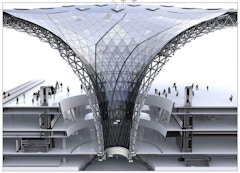
Sustainable Materials
Stainless steel has been successfully used in building envelopes since the completion of the Chrysler building in 1928. Today, it is used as both a s…

Stainless steel has been successfully used in building envelopes since the completion of the Chrysler building in 1928. Today, it is used as both a s…

Urban noise pollution is a major environmental health problem. International organizations are making efforts to prevent health damage due to high le…

Silicone materials have a long history in high performance building projects. Known for durability, they can reduce a building’s carbon footprint by …

Highly transformable materials can be used as adaptive exterior shading systems by leveraging the relationship between external stimuli (heat) and re…

Connections, those transitions between systems and materials, are critically important when the surfaces are curved or complex. Well-designed connect…

Architects today must explore alternative enclosure materials to meet evolving energy codes and embodied carbon regulations. Terra cotta has been mos…

Architecture has traditionally celebrated the joining of two building components or materials. Joinery serves as a key site for architectural express…

All too often, high-performance building envelopes are considered in terms of new materials and technologies that push specific systems to improve en…

The performative and visual aspects of curved forming/bending thin “formable” planar materials is explored. Early tests for deflection indicate that …

Facade engineering aims at appropriately balancing the demands imposed by the context and the capabilities inherent to the materials, the geometries …

Architectural design freedom achieved on high-end projects currently costs over $1,000/sq. Ft. Building materials have long been relegated to plane s…

This article discusses design, prototype development and a simulation study of novel types of facade systems, which integrate thermoelectric (TE) mat…

Navigating the building code, while challenging in any respect, can be even trickier when considering the use of emerging materials on building facad…

This paper will focus on the design and detailing of large-format glass enclosures intended to maximize transparency using state-of-the-art materials…
The stability of monolithic glass fins is reasonably well defined; as an elastic material it behaves in a similar manner to other elastic materials s…

Heat transfer through building facades can occur by any combinations of conduction, convection, and/or radiation. Conductive heat transfer depends on…

In the last few years, the design community has embraced the challenge of reducing embodied carbon in buildings. Several tools are now available for …

This article presents results of a research study that focuses on understanding energy performance of novel facade systems that integrate thermoelect…
Climate change goals will require significant improvements in the way buildings are constructed and operated. Building reuse can combat climate chang…

Thermal-break-blanket technology is a novel and high-performance thermal break solution for aluminum curtain walls. The thermal-break-blanket is inst…